Introduction: A Venetian Eye on Europe
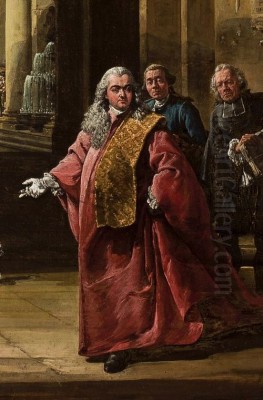
Bernardo Bellotto stands as one of the most significant view painters, or vedutisti, of the 18th century. Born in Venice, the heart of this artistic tradition, he emerged from the shadow of his illustrious uncle, Giovanni Antonio Canal, better known as Canaletto, to forge a distinct and powerful artistic identity. Operating within the Rococo period, Bellotto specialized in detailed, often large-scale depictions of European cityscapes, working for some of the continent's most powerful courts.
His career was marked by extensive travel, taking him from his native Italy to the major capitals of Central and Eastern Europe, including Dresden, Vienna, Munich, and Warsaw. Unlike the often sun-drenched canvases of his uncle, Bellotto developed a style characterized by cooler light, dramatic contrasts of light and shadow, and a meticulous attention to architectural detail and atmospheric effect. His works are not merely artistic achievements; they serve as invaluable historical documents, capturing the appearance of cities that would later undergo dramatic transformations.
Early Life and Venetian Roots
Bernardo Bellotto was born into an artistic milieu in Venice, likely in 1721 or 1722. His mother was the sister of the renowned Canaletto, and it was in his uncle's thriving workshop that the young Bernardo received his artistic training. Venice at this time was a vibrant center for the arts, with painters like the great Giambattista Tiepolo creating spectacular decorative schemes, while Canaletto catered to the burgeoning demand, particularly from Grand Tourists, for souvenir views of the city's famous landmarks.
Bellotto quickly absorbed the techniques of the veduta tradition, learning how to construct convincing perspectives and render intricate architectural details. He likely assisted his uncle on numerous commissions before establishing himself as an independent master. Around 1738, he was accepted into the Venetian painters' guild, the Fraglia dei Pittori, a testament to his burgeoning skills. His early works, while indebted to Canaletto's style, already hint at a more sober palette and a greater interest in the play of light across surfaces.
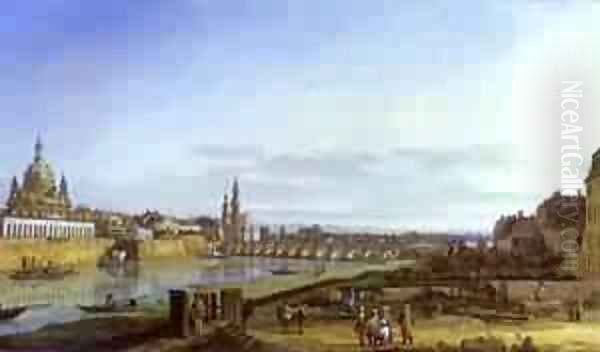
Before leaving Venice permanently, Bellotto embarked on travels within Italy during the early 1740s. He visited cities such as Florence, Rome, Lucca, Turin, Milan, and Verona. These journeys allowed him to study different urban environments and architectural styles, broadening his artistic horizons beyond the Venetian lagoon. Paintings from this period, like his views of the Arno in Florence or Roman landmarks such as the Castel Sant'Angelo, demonstrate his growing confidence and the gradual emergence of his personal style, setting the stage for his international career.
The Call to Dresden: A Saxon Court Painter
A pivotal moment in Bellotto's career arrived in 1747 when he accepted an invitation from Augustus III, Elector of Saxony and King of Poland, to work at his court in Dresden. This move marked the beginning of a long and fruitful period spent largely outside Italy. Appointed as a court painter (Hofmaler), Bellotto enjoyed significant patronage and produced an extraordinary series of views depicting Dresden and its surroundings.
His Dresden canvases are among his most celebrated works. He painted the city from various viewpoints, capturing its magnificent Baroque architecture along the Elbe River. Works like Dresden from the Right Bank of the Elbe above the Augustus Bridge showcase his mature style: a cool, often silvery light, meticulous rendering of buildings like the Frauenkirche and the Hofkirche, deep, dramatic shadows, and a sense of monumental scale. He frequently employed the camera obscura, an optical device that aided in achieving topographical accuracy, but his artistic vision transformed these precise renderings into powerful atmospheric statements.
Bellotto's time in Dresden placed him within a different artistic context. He would have been aware of German contemporaries, such as the landscape painter Johann Alexander Thiele and the versatile Christian Wilhelm Ernst Dietrich. While his Italian training remained foundational, his engagement with the Saxon capital produced a unique body of work. Tragically, the beauty he captured was largely destroyed during the Allied bombing raids of World War II. Bellotto's detailed paintings subsequently became crucial, almost blueprint-like resources for the painstaking reconstruction of Dresden's historic center, lending his work an unforeseen historical significance.
Vienna and Munich: Imperial Commissions
The outbreak of the Seven Years' War in 1756 disrupted court life and artistic patronage in Dresden. Bellotto sought opportunities elsewhere, leading him to Vienna around 1758. Here, he found favour with another powerful monarch, Empress Maria Theresa of Austria. He spent several years in the Habsburg capital, producing a series of impressive views that documented the city and its imperial palaces.
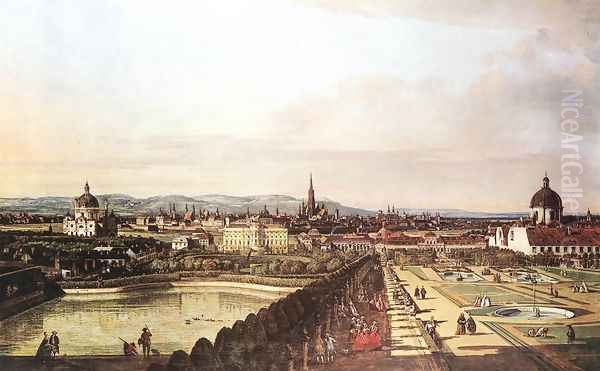
Among his notable Viennese works are the panoramic views of the city, often taken from the vantage point of the Belvedere Palace, the summer residence of Prince Eugene of Savoy. These paintings, such as Vienna from the Belvedere, capture the sprawling cityscape, the Danube River, and the surrounding countryside under his characteristic cool, clear light. He also painted detailed views of Schönbrunn Palace, Maria Theresa's favoured imperial residence, documenting its architecture and gardens with his customary precision.
Following his Viennese sojourn, Bellotto spent time in Munich from around 1761, working for the Elector of Bavaria, Maximilian III Joseph. He produced views of the Bavarian capital and the Nymphenburg Palace. Although his stay in Munich was shorter than his periods in Dresden or Vienna, it further cemented his reputation as a leading European view painter, sought after by ruling houses across the continent. His works from this period continued to display his mastery of perspective, detail, and atmospheric rendering.
Warsaw: The Final Chapter and Royal Patronage
Around 1767, Bellotto embarked on the final major phase of his career, moving to Warsaw. He had initially intended to travel to the court of Catherine the Great in St. Petersburg, but an invitation from the newly elected King of Poland, Stanisław August Poniatowski, persuaded him to remain in the Polish capital. The King was an enthusiastic patron of the arts and sciences, determined to make Warsaw a major cultural center. Bellotto was appointed court painter and spent the rest of his life there.
This Warsaw period was exceptionally productive. Bellotto created a comprehensive series of views depicting the city, its royal residences, and surrounding landscapes. Masterpieces from this era include View of Warsaw from the Praga District, offering a panoramic sweep of the city across the Vistula River, and View of Warsaw from the Terrace of the Royal Castle, showcasing the bustling life around the royal palace. He also painted large canvases of royal properties like Ujazdów Castle. These works are characterized by their immense detail, capturing not only architecture but also the daily life of the city's inhabitants.
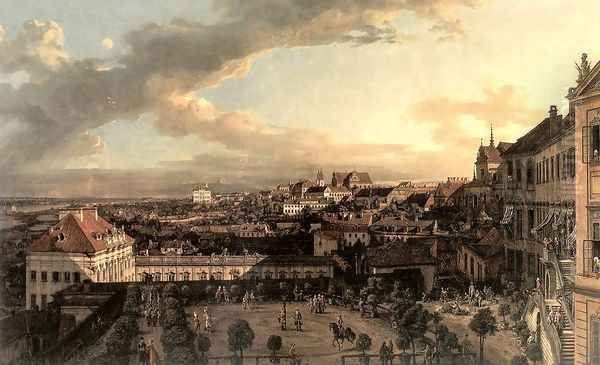
Under King Stanisław August's patronage, Bellotto also undertook ambitious historical paintings, a departure from his usual vedute. These included large canvases depicting significant events in Polish history, such as The Election of Stanisław August and The Entry of Jerzy Ossoliński into Rome in 1633. These works demonstrate his ability to handle complex multi-figure compositions while retaining his sensitivity to light and atmosphere. Bellotto's influence extended to local artists; Polish painters like Zygmunt Vogel and Marcin Zaleski became his followers, continuing the tradition of detailed cityscape painting in Poland. Bellotto died in Warsaw in 1780, leaving behind a rich legacy in his adopted city.
Artistic Style and Technique: Beyond Canaletto
While Bernardo Bellotto's artistic journey began under the tutelage of his uncle Canaletto, he developed a highly individual style that distinguishes him clearly from his famous relative. Where Canaletto's Venice often basks in warm, golden sunlight, Bellotto's views frequently feature a cooler, more analytical light, sometimes described as silvery or even steely. This coolness is often accentuated by strong contrasts between brightly lit areas and deep, sharply defined shadows, lending his work a dramatic, sometimes austere, quality.
Bellotto was a master of architectural rendering. His depiction of buildings is characterized by meticulous accuracy and a strong sense of volume and geometric structure. He excelled at capturing the textures of stone, brick, and plaster. This precision was undoubtedly aided by his skilled use of the camera obscura. However, Bellotto was no mere copyist; he manipulated perspective and composition for artistic effect, often choosing viewpoints that emphasized the grandeur or specific character of a location. His paintings are imbued with a palpable sense of atmosphere, capturing the specific quality of light and air of each city he depicted.
Beyond the realistic vedute, Bellotto also produced capricci – imaginary or fantasy views that combined real architectural elements with invented settings, often featuring classical ruins. These works allowed him greater imaginative freedom. When comparing Bellotto to other Venetian contemporaries like Michele Marieschi, known for his dynamic, slightly theatrical perspectives, or Francesco Guardi, celebrated for his looser brushwork and evocative, almost romantic atmosphere, Bellotto's commitment to sharp focus, detailed realism, and controlled composition stands out. His approach was more objective, yet deeply infused with his personal vision of light and space. The precision he achieved also finds parallels in the meticulous etchings of Roman views by his Italian contemporary, Giovanni Battista Piranesi, although Bellotto's paintings possess a unique painterly quality.
The Master Etcher
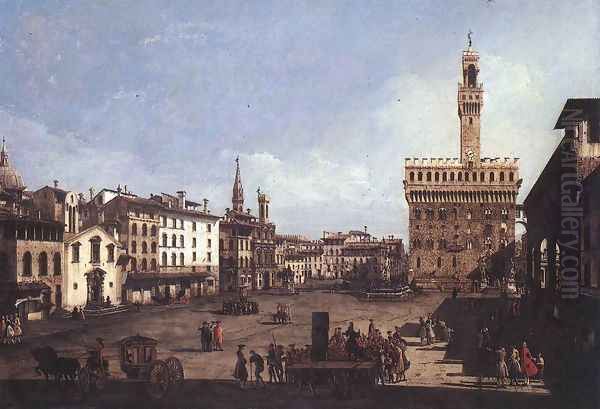
In addition to his prolific output as a painter, Bernardo Bellotto was also a highly accomplished etcher. He created a significant body of prints, often based on his own paintings, further disseminating his views of Dresden, Warsaw, and other locations. His etchings display the same characteristics found in his canvases: remarkable precision, fine detail, and a sophisticated understanding of light and shadow translated into the linear medium of printmaking.
His etched work required immense technical skill. He masterfully employed varied lines and hatching techniques to render different textures, from the smooth surfaces of classical columns to the rougher fabric of everyday buildings or the foliage of trees. The play of light is just as crucial in his prints as in his paintings, with deep shadows creating dramatic contrasts and defining architectural forms. These prints were not only works of art in their own right but also served a documentary function, providing wider access to images of these important European cities.
The etchings, like the paintings, stand as important records of 18th-century urban environments. They capture the architectural ensembles, street life, and surrounding landscapes with an accuracy that complements his painted oeuvre. Bellotto's dedication to both painting and etching demonstrates his versatility and his commitment to exploring the visual potential of the cityscape across different artistic media. His prints are highly valued by collectors and institutions today.
Legacy and Influence: Documenting Europe
Bernardo Bellotto's legacy is multifaceted. He ranks among the foremost European view painters of the 18th century, a master whose technical brilliance and distinct artistic vision set him apart, even from his celebrated uncle, Canaletto. His development of a cooler, more dramatic, and rigorously detailed style offered a powerful alternative to the sunnier depictions often associated with Venetian vedute. His influence was particularly strong in the regions where he spent significant portions of his career.
In Poland, his long residency and role as court painter left a lasting mark. Artists like Zygmunt Vogel and Marcin Zaleski directly inherited his approach to cityscape painting, establishing a Polish school of veduta painting that flourished into the 19th century. His impact, however, extends far beyond direct artistic lineage. The extraordinary historical circumstances of the 20th century gave his work an unforeseen practical importance.
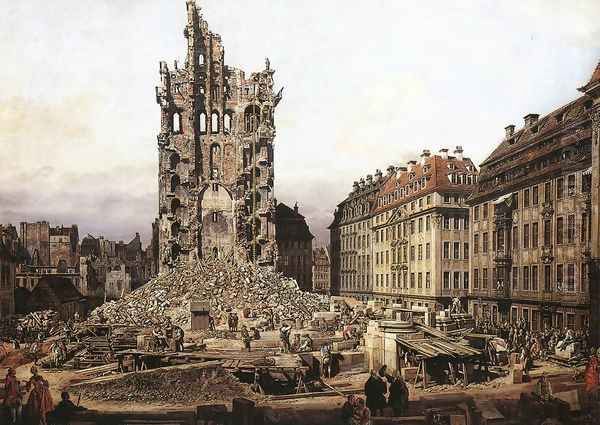
The meticulous accuracy of his views of Dresden and Warsaw proved invaluable after the devastation of World War II. His paintings and etchings served as vital references for the architects and conservationists involved in the complex and sensitive task of reconstructing the historic centers of these cities. This has cemented Bellotto's reputation not only as a great artist but also as an unintentional chronicler whose precise vision helped restore fragments of Europe's lost heritage. Today, his works are held in major museums across the globe, including the Gemäldegalerie Alte Meister in Dresden, the National Museum in Warsaw, the Kunsthistorisches Museum in Vienna, the National Gallery in London, and the Metropolitan Museum of Art in New York, ensuring his precise vision continues to be admired.
Conclusion: A Unique Vision
Bernardo Bellotto carved a unique path through 18th-century European art. Emerging from the formidable shadow of Canaletto, he travelled extensively, absorbing the character of diverse cities and translating them onto canvas and copper plate with extraordinary skill and a distinctive artistic sensibility. His cool light, dramatic shadows, and unwavering commitment to detail created cityscapes that are both topographically precise and atmospherically charged. Serving kings and empresses, he documented the splendors of Dresden, Vienna, Munich, and Warsaw, leaving behind a body of work that is artistically compelling and historically invaluable. More than just a nephew of Canaletto, Bellotto stands as a major master in his own right, a painter whose precise vision continues to captivate and inform centuries after his death.